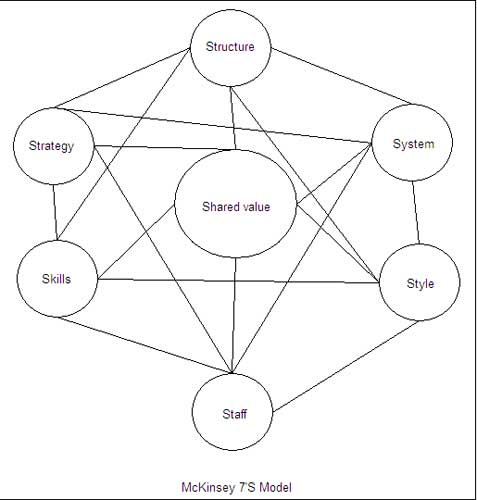McKinsey developed this model in the 1970’s to determine the ease or ability of an organization to adapt to change. The primary focus of this model is on coordination. It is an excellent tool for self-diagnosis of problems by organization as it clearly bares the problem areas of the organization and highlights them. Even though it was proposed in the 1970’s, it still has some use in today’s ever changing organizations. The component elements of this model are:
- Style-the first constituent element of this model is the style of functioning of the organization, its organizational culture and climate.
- Skills-the second element is the skill set of the organization and its people.
- System-is the third element of the model. The processes and systems make the organization which are used to maintain control and used for directing.
- Structure-is the fourth element of this model. It refers to the structure of the organization, i.e., rigid or flexible. It also indicates the powers of the executives and the channels through which the power is to be exercised.
- Staff-is the fifth constituent of the model and it refers to the employees of the organization.
- Strategy-is the sixth element and it stands for the activities that the organization indulges in for gaining competitive advantage in the market.
- Shared value-is the seventh and last element of the model and it refers to the common set of values that each employee of the organization stands for. This has today gained importance in view of the series of corporate governance challenges that are being faced by the companies.

Information is required in both strategy planning and strategy implementation. Without the right information about opportunities, threats, markets and changes in business environment, competitors and their plans, the organization’s own strengths and weaknesses and government guidelines and polices, business strategy can neither be planned nor the planning be implemented with elan. Information thus plays a very crucial role in strategy. This fact was however ignored by the top management until the mid-nineties when top executives began to realize the connection and the potential to leverage information systems for strategy development and implementation. Today in most organizations there is a buy in by top management on this linkage between strategy and information systems. In fact, information systems are now being developed in a way that they are aligned to the strategy and help in its planning and implementation. Thus, a new concept of strategic information systems has developed. New developments in the field of information management and information systems have contributed to the development of this area.
 Dinesh Thakur holds an B.C.A, MCDBA, MCSD certifications. Dinesh authors the hugely popular
Dinesh Thakur holds an B.C.A, MCDBA, MCSD certifications. Dinesh authors the hugely popular